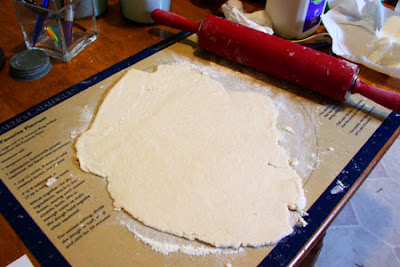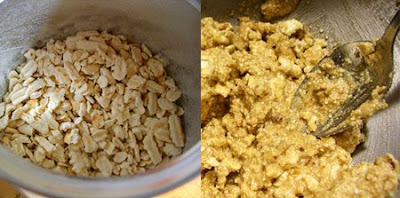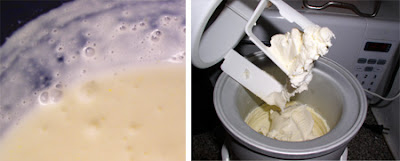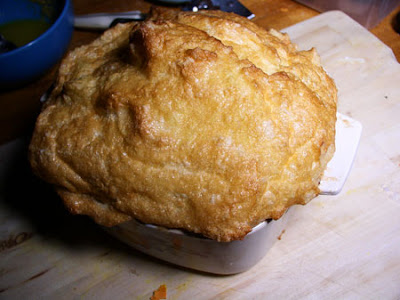 Roly-Poly Pudding.
Roly-Poly Pudding.
Breakfast: Cocoa and Fried Polenta
Last night, I went to bed with a pounding headache, that no amount of Tylenol seemed to help. I lied awake for hours–during this project, I’ve had a lot of trouble sleeping. I’m so hungry by the time I turn in, that the sensation of it keeps me awake. I’m too famished to get up and do anything else, but too uncomfortable to drift off the sleep. I wake up the next morning exhausted.
This morning, I could barely open my eyes when my alarm rang. “It’s okay,” I told myself. “You get to have hot chocolate this morning.” I had been looking forward to it all week.
I slipped into my robe and shuffled into the kitchen…only to see 2 empty milk jugs on the kitchen table. One of my roommates had polished off not only the skim milk, but also my whole milk which they had earlier this week declared “disgusting.” I opened the fridge to find a carton of half and half. “I’ll use this,” I thought. “The cream will give me strength!”
I poured it into my mug…and it came out in chunks. It was beyond spoiled. “Is there no god damn milk?” I screeched. I shoved my feet in my boots and put on my coat–angrily–and went to the corner bodega to buy milk. The snowstorm the night before had turned the world into a sheet of ice. As I scooted down the sidewalk, hanging onto the sides of buildings, I cursed everything.
Finally, I got back and mixed up my hot chocolate. The cocoa was a gift from my brother. It was delicious. Corson recommends accompanying it with fried lentils; I didn’t have any lentils left over, so I fried up the rest of my polenta. Delicious, and very satisfying.
I collapsed on the couch, feeling too awful to move.
“You look like shit!” My roommate declared.
“I feel like shit.”
“That’s because you don’t eat anything.” Thanks, Jeff.
Cost: .40 cents.
Lunch: Haslet Stew and Roly-Poly Pudding
I started on the Roly-Poly Pudding first, since it needed to boil for two hours:
“Suet Roly-poly.-Sift together one pound of flour. two teaspoonfuls of salt, and one teaspoonful of baking powder, (cost about five cents,) rub into them two ounces of sweet drippings, (cost one cent;) mix with two gills of milk, or one egg, and two gills of water…roll out half an inch thick, spread with quarter of a pound of chopped suet, (cost two cents,) one teaspoonful of salt, a little spice of nutmeg, and two tablespoons of sugar (cost two cents); roll it up, tie it tightly in a well floured cloth, and boil steadily for two hours in a large covered pot.”

I consulted with my mother to see what she thought “sweet drippings” were. We decided it was probably like grease, and perhaps “sweet” was synonymous with “fresh.” Regardless, I decided  to substitute lard (.19 cents), and rubbed it in with the flour and other ingredients. After adding the milk (.13 cents) and water, the dough was a little thin, like muffin batter. I added a little more flour until it was the consistency of cookie dough and rolled it out. For some reason, I drew a line at asking my butcher for suet, and also substituted lard. I rolled it up with the other seasonings.
to substitute lard (.19 cents), and rubbed it in with the flour and other ingredients. After adding the milk (.13 cents) and water, the dough was a little thin, like muffin batter. I added a little more flour until it was the consistency of cookie dough and rolled it out. For some reason, I drew a line at asking my butcher for suet, and also substituted lard. I rolled it up with the other seasonings.
I took a pillow case that I had rinsed and dried to get rid of any laundry detergent residue, and shook flour inside. I placed my dough-log in it, tied it up, and placed it in a pot of boiling water. See you later, roly-poly pudding.
Meanwhile, I prepared the haslet stew:
“Haslet Stew.-For this dish use a fresh pig or sheep’s haslet…cut them in two inch pieces, put them into a sauce-pan with one ounce of salt pork diced, an onion chopped, one dessert spoonful of salt, and half a tablespoonful of black pepper ; two bay leaves, two sprigs of parsley and one of thyme, tied in a bouquet, (cost of seasoning one cent.) one ounce of flour. one gill of vinegar, half a pint of cold gravy or cold water, and six potatoes peeled and cut in dice, (cost of all these about five cents) stew these ingredients gently together for two hours, and serve as you would a stew, with a tablespoonful of chopped parsley sprinkled over the top, and bread to eat with it. It will give you a good dinner for about fifteen cents.”
Haslet is a bag of pig offal, livers and hearts and things. While there was all variety of offal available at my local butcher, I had to buy the beef chuck steak from yesterday’s dinner in a pack of two. I decided to save a few cents, and replace the haslet with beef.
I tenderized the beef chuck steak ($1.40) and dredged it in flour, pepper and salt, then browned it in a saucepan with a slice of bacon (.15 cents) and half an onion (.05 cents). I poured in a cup of water to deglaze, then added two diced potatoes (.34 cents), a bay leaf, a handful of parsley (.15 cents), and 1/2 teaspoon dried thyme. I added more water, then simmered the pot for about an hour.
 I don’t understand why this photo came out looking like a postcard from the ’70s.
I don’t understand why this photo came out looking like a postcard from the ’70s.
I ate it with a hunk of bread (.07 cents) and it tasted like real food. The beef was tender from it’s long simmer, and the few herbs made for a flavourful broth. It was fine.
I took the roly-poly pillowcase out of the boiling water. It was hot as hell. I slowly unrolled it and scooped out the pudding, which was stuck to the sides of the bag (which still smelled a little like laundry). It tasted better that it looked, especially with a little sugar sprinkled on top. But it was salty–so salty! I wouldn’t make it again.
Cost: 2.33
And to be honest, I’m so full from lunch, that I don’t think I’m going to make Cheese Pudding (a cheesy polenta) tonight for supper. I’m just going to finish up the night with an extra cup of milk (.25 cents).
Total cost: 2.98
Approximate Calories Consumed: 1,390
7-Day Total: about $19.16
Tomorrow, we’ll discuss what we’ve learned.
 Chicken cookies triumphant.
Chicken cookies triumphant.
 Marco skims for schmaltz. What a great guy.
Marco skims for schmaltz. What a great guy. Left: Matzo farfel. Right: Mock Oatmeal Dough.
Left: Matzo farfel. Right: Mock Oatmeal Dough.













